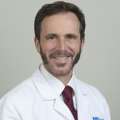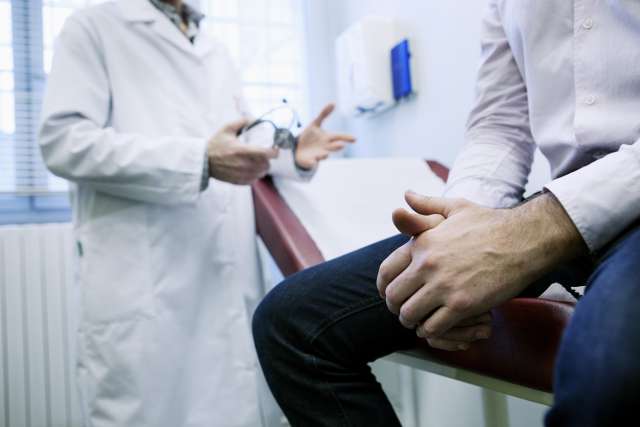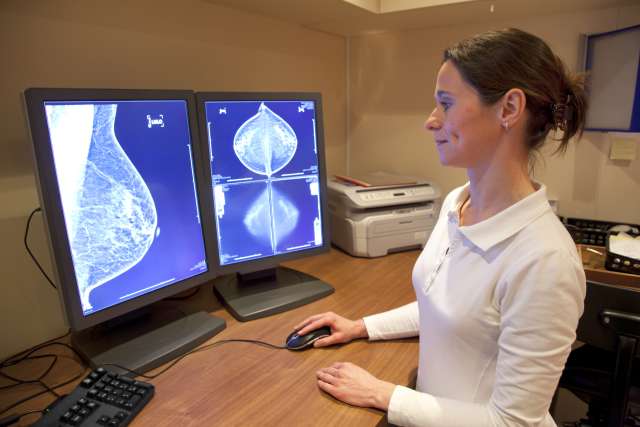When , was visiting Hearst Castle with his wife five years ago, prostate cancer was not on his radar.
He was a clinical research scientist who spent his career studying heart disease and heart failure so, as he puts it, “Prostate cancer was outside my comfort zone.”
But when Dr. Ardell, now 70, director of the UCLA Neurocardiology Research Program of Excellence, began experiencing stabbing back pain on that trip, he knew something was wrong. When he returned to L.A., he underwent an extensive series of tests, including a prostate-specific antigen test, which measures the level of PSA, a protein produced in the prostate gland. A PSA from 0-4 is considered within normal range.
The test results revealed his PSA, at 190, was significantly elevated, and he was subsequently diagnosed with prostate cancer. What’s more, further testing, with advanced PET scanning, showed the cancer was advanced, having spread from his prostate to other areas of his body.
This ruled out typical treatment for early-stage prostate cancers.
“I was stage 4 when they found out. They couldn’t perform a prostectomy (removal of the prostate gland), and they couldn’t radiate me, so they really had to go after things aggressively,” says Dr. Ardell, who is also a professor in the Department of Medicine/Cardiology at the David Geffen School of Medicine at UCLA.
That’s when he was introduced to , medical director of the of the Institute of Urologic Oncology at UCLA and a member of the .
High prevalence
The prostate gland sits below a man’s bladder and is part of the male reproductive system. Typical early-stage symptoms of prostate cancer may include difficulty starting urination, frequent urination, pain when urinating, blood in the urine or semen, and pain in the back, hips or pelvis that doesn’t abate.
According to the American Cancer Society, will be diagnosed with prostate cancer this year, and experts predict the number may soon exceed that of breast cancer diagnoses. The disease is — second only to nonmelanoma skin cancer, according to the Centers for Disease Control and Prevention.
Prostate cancer affects about one in eight men (and about one in four African American men), primarily those older than 50, and is the second-leading cause of cancer-related mortality in men, after lung cancer. Caught early, localized prostate cancer is, for the most part, highly curable, says Dr. Rettig, who notes that men have differing risks of recurrence and mortality, even when diagnosed in the early stages.
“Most recurrences develop in patients who have high-risk prostate cancer, meaning a higher PSA at diagnosis, a higher-grade cancer that looks more aggressive under the microscope, and a higher clinical stage that is more advanced within the prostate itself,” Dr. Rettig explains.
He adds that recurrence of the disease occurs in one-third of those diagnosed in the early stages.
Still, even metastatic prostate cancer, such as Dr. Ardell’s, can be effectively treated to where it is almost considered a chronic illness, he says.
Treatment begins
Since surgery was not an option, Dr. Ardell began his treatment with a hormonal therapy called ADT (androgen deprivation therapy), which deprives the tumor of male hormones by “medical castration” – drugs that block the production of testosterone from the testes.
“Hormonal therapy has been the backbone of treatment for 80-plus years,” Dr. Rettig says. “We now know that when we add other drugs on top of that, we improve life expectancy considerably. Those drugs are most commonly hormonally active agents that completely block the hormonal milieu, leading to better outcomes.”
Dr. Ardell did well with hormonal therapy for about 18 months, but after dropping to a low of 0.20, his PSA began rising. A new, innovative approach was thus indicated to deal with his evolving disease.
Amgen clinical trial
Eventually, as the castrate-resistant cancer cells (those resistant to hormonal therapy) started to take over, the ADT treatment began to lose effectiveness, as evidenced by the rising PSA level. That’s when Dr. Rettig asked Dr. Ardell if he was interested in going into an Amgen clinical trial, a phase I, first-in-human study to evaluate the safety and tolerability of acapatamab, a half-life extended bispecific T-cell engager, alone and in combination with other targeted therapy drugs.
Dr. Rettig, the principal investigator for the trial at UCLA, explains how it works: An antibody-like drug is engineered so that half recognizes a protein on the surface of the cancer cell (called prostate-specific membrane antigen, or PSMA) and the other half recognizes a protein on an immune cell called a T cell (CD3), which, in turn, brings the tumor cell and the T cell together to activate the T-cell immune response toward the tumor.
“The idea is that this approach not only recruits cancer cells to the tumor microenvironment but also activates those immune cells against the cancer, thereby killing the tumor,” Dr. Rettig says.
Immunotherapy has been successful in treating a range of cancers, including lung and gastric cancers and advanced melanoma. Many of these have come out of clinical trials conducted by UCLA Health researchers.
“It was intriguing to me because it used targeted immunotherapy to treat the disease,” Dr. Ardell says. “The drug would go in and bind to your T cells and circulate in the body until it found the cancer cells, latch on and kill them, almost like a Pac-Man game.”
Dr. Ardell was a good candidate for the trial given that he had had prior treatments for prostate cancer and his symptoms were minimal, Dr. Rettig says.
Early results promising
Dr. Ardell responded quickly on the trial. As a result, he was kept on it for about 10 months. During that time, his PSA level was continually monitored, and it dropped almost tenfold, from 12.3 to 1.3.
“I thought, ‘Oh boy, we’ve got this made,’ ” Dr. Ardell recalls. Although he experienced some adverse side effects from the drug, he pushed his way through, hoping the treatment would succeed.
“After the first infusion, my body adjusted, and I would get therapy every two weeks,” he says. “The nice part of this trial is they do a lot of high-level scans to give them an objective view of what’s going on with the therapies and the disease. That’s the benefit of being at an institution like UCLA where you get easier access to experts and equipment you might not get elsewhere.”
I've always felt that this is a multi-year job of staying on top of where I am currently and where I need to go and adjust as we move from one treatment to another.
DR. JEFFREY ARDELL
But prostate cancer is a feisty disease, he notes. After several months on the trial, his PSA level began to climb again, so another treatment was introduced, using focal radiation to treat spot breakthrough points. Eventually, he received as much radiation as allowed. He then moved onto another hormonal approach followed by a six-month period of systemic radiation injections in the form of a radioactive type of radium, a mimic of calcium that is effective for the treatment of bone metastases. This treatment did a good job of stabilizing the effects of the cancer in his bones.
Currently, Dr. Ardell is taking part in a second clinical trial using traditional chemotherapy with the addition of an experimental drug that also targets cancer cells.
He does not let failed therapies faze him.
“I’ve always felt that this is a multi-year job of staying on top of where I am currently and where I need to go and adjust as we move from one treatment to the next,” Dr. Ardell says. “And I couldn’t ask for a better treatment team.”
Developing new therapies
While Dr. Ardell and others did achieve a protracted response on the Amgen trial, many other participants did not, Dr. Rettig says. During the early stages of treatment, patients experienced adverse effects as a consequence of over-activating the immune system. For this reason, Dr. Rettig says, this particular product probably won’t be further developed.
Still, he has reasons to be encouraged.
“There’s a lot going on in this space with these types of immunotherapies,” he says. “We’re trying different combinations of drugs, trying to gain more activity with fewer side effects. There are ways of engineering therapies to try to reduce their toxicity, but the other aspect of it is how can we make the immune system more active against the tumors.”
Dr. Rettig notes that immune therapies are a challenge to develop in prostate cancer versus other cancers because, for various reasons, there are very few immune cells in the microenvironment around prostate cancer.
“When we see immunotherapies work in other cancers, those tumors have an immunologically hot environment at baseline. We’re bringing the immune system over the finish line when we’re giving these patients the therapy, whereas with prostate cancer, there is a long way to go to create the immunologic environment that would render tumors more susceptible to immunostimulant therapies,” he says.
Trusting his team
Meanwhile, Dr. Ardell tries not to overthink his therapies and to trust his clinical team.
“They are at the top of their game in terms of deciding what makes the most sense,” he says. “Each person is different, and each responds to therapy differently. I’ve always felt they have given me rational approaches as I go from one therapy to the next.”
In retrospect, Dr. Ardell wishes he had prioritized his prostate health by insisting his primary care physician preemptively screen him for the disease, starting at the recommended age of 50 for men of average risk.
He also regrets ignoring some of the symptoms he was experiencing.
“This process started at 65, and by then I was experiencing some problems in terms of urine flow and other aspects that should have been immediate triggers for getting screened,” he says. “I fault myself for not insisting on it.”
He credits his strong faith in God and the support of his family for getting him through the worst times. “It’s a disease that impacts the whole family, and that support is critical,” Dr. Ardell says.
And although the many therapies he’s been given have sapped his strength and stamina, he is grateful for each of them. He continues to maintain an internationally recognized research program at UCLA and says he is grateful to contribute to the evolution of new therapies for cardiac disease.
As for his prostate cancer journey, Dr. Ardell says:
“I feel I’m alive today because of the therapies they continue to give me, and I feel I have a long time ahead of me, with my doctors’ guidance.”
Jennifer Karmarkar is the author of this article.




